Look Up: What Are You Looking For? Part 1 – The Moon and Planets
Astronomy is one of those pursuits that very few ever take up. Yet, we all look up at the night sky occasionally. Sometimes the Moon rising looks so big that it’s hard to ignore, yet like our Sun, most just take it for granted, as it’s almost always there so we’ve become a bit jaded by it.
Sometimes people will stargaze on a clear night, sitting out and looking up at the night sky and thinking about what a nice night it is, before they light a fire to sit around, blocking the sky view with smoke and light pollution. I often get questions from people asking me what some of those bright stars are up in the sky, surprised to find that they aren’t stars at all, but some of our biggest and closest planets. “Close” being a relative term.
So what are we looking at up there? And for those of you with more than a passing interest, what are you looking for? With that, I’m writing a series of blogs aimed at educating those who take a bit more interest than the casual “stargazer”. All but a few of these blogs are aimed at beginners, some with only rudimentary knowledge of the Universe, so not all of these blogs will appeal to everyone.
Where to start? Well, if you read my last blog, “An Astronomical Perspective” you may already know that there is a lot more than meets the eye. It’s important to know where to start if you want to learn to navigate the night sky. Even the basic understanding of our place in the Universe, or how to find objects in it can be a bit daunting, with or without the optical aid of binoculars or a telescope. I’ll save the choice of equipment for other blogs to follow and begin with what we can see with our eyes alone and how to orient yourself to the night sky. So please bear with me if any of this is a little oversimplified. Some who are just starting out may need information that others find a bit boring. We all have to start somewhere.
So let’s start with our solar system and where it is relative to the rest of the Universe.
Our Solar System contains one single bright star we call the Sun. It lies 93 million miles away from us. Just close enough to support life here without burning us alive, yet just far enough that we also don’t become a frozen wasteland with no life. As discovered long ago, it is only the center of our solar system, not anywhere close to being the center of our Milky Way galaxy, much less the entire Universe as it once was thought to be.
So where are we exactly? Do you know? We live in one galaxy out of billions in the Universe. Our single galaxy, the Milky Way consists of a core of bright stars compacted together, being drawn into a giant black hole that is slowly consuming everything spiraling around it. If one could see our galaxy from outside it, it would appear like a giant whirlpool, spinning about this black hole, as if it were going down the drain. Though we live inside the Milky Way we can’t see this core because it is blocked by enormous clouds of interstellar dust lanes, contained within spiraling arms.
Our entire solar system, (the Sun and all the planets) reside within one single spiral arm going around the core, about 26,000 light years from the core (as seen in this photo below).
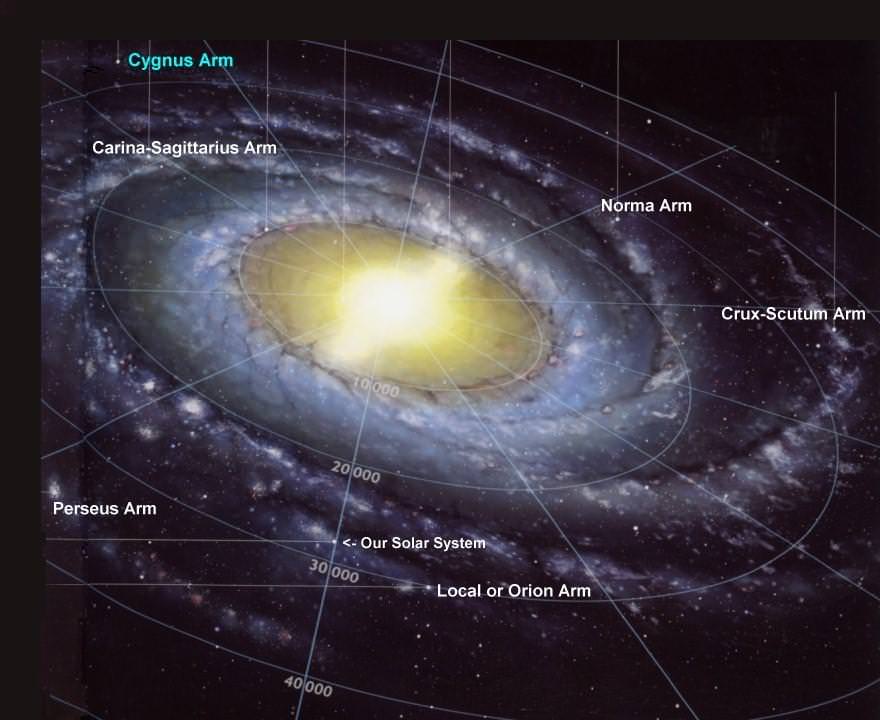
Where our solar system lies in the Milky Way
Our solar system is about 7,440,000,000 miles in diameter. That is “7 billion, 4.4 million” miles in diameter, or .00127 light years wide. A fact to keep in mind as you read my astronomy blogs, is that a light year is the distance light can travel in one Earth year. And that distance is an astonishing 6 trillion miles! Keep this in mind because the enormity of our Universe needs this frame of reference for us to (somewhat) comprehend the vastness of space. So when I tell you we live 26,000 light years from the core our galaxy, that’s 26,000 X 6 trillion miles. We use light years because it’s easier than writing out 156,000,000,000,000 miles. And believe it or not, as big as that number appears, it is almost nothing in relation to size and distance of other objects in the Universe. So again, remember this fact: 1 Light Year = 6 Trillion Miles. I will use it often in describing size and distance.
Almost every star we see is located only within this one spiral arm, so we can’t even see the other arms of our own galaxy much less the stars that lie within them. Just the one we live in, called the “Orion Arm”. Anything that lies outside our Orion arm that we can see are mostly other entire galaxies light years beyond our own. Besides our ability to see those other galaxies, all other objects we see lie within our Orion arm, and that includes all the visible stars and nebulae. Nebulae are where former stars have gone “supernova”. They exploded apart, spreading their gasses far out into our spiral arm where gravity will condense the gas into new stars.
So, on a warm summer evening, if you happen to look up under a dark sky, away from city light pollution and see the “Milky Way”, know that the beautiful, star-studded cloud structure running from zenith (high overhead) to the horizon, is only a small part of the Orion Arm, not the entire arm, nor the whole Milky Way.
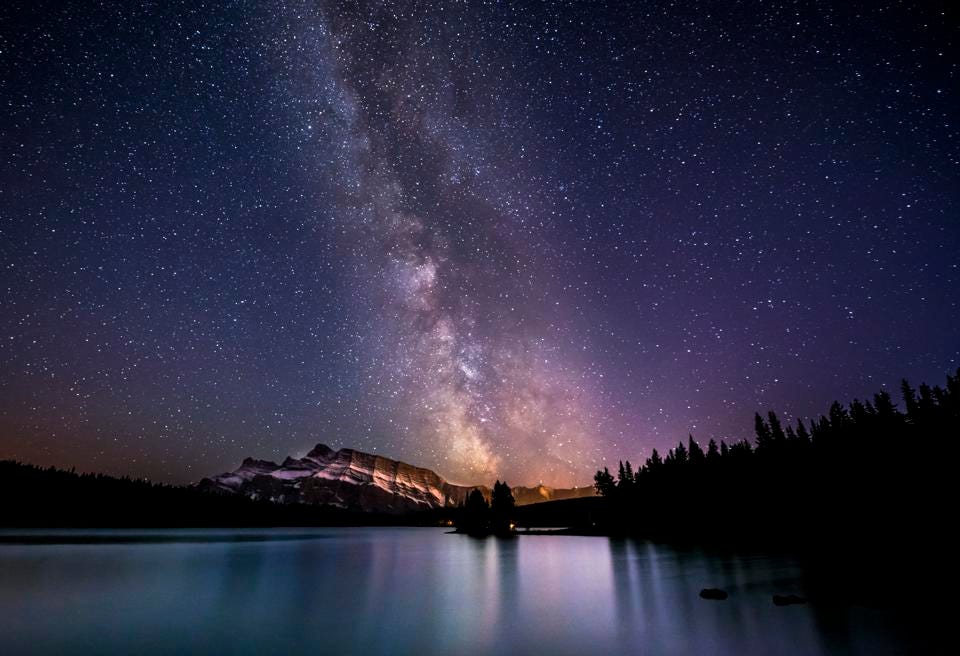
Orion Arm (the small part we see), of the Milky Way Galaxy
Now that you know where our solar system is in the Milky Way, let’s explore this tiny region we call the “solar system”. A solar “system” is comprised of a single star in the center, with the gravitational pull to keep the contents of this system from “flying away”, off on their own. Thus we have our own “star” (the Sun), which is the only star in our “system”. Every other star we see lies outside our solar system. Locked in by gravity lies 9 planets (or 8 depending on how one views Pluto). The planets all have different, elongated, elliptical (not circular) orbits around the Sun which changes their distance from us as they orbit the Sun. Sometimes these planets are closer to us, and sometime further away. There are two “inner planets” (between Earth and the Sun) and six “outer planets” that are out beyond us from the Sun. Five of the outer planets lie outside what is called the Asteroid belt (a circular belt of rock and ice, from where many of the comets we see, come from).
In order to gain some perspective on distance, even within our “tiny” solar system, it is important to know where we (planet Earth) are, relative to the other planets, in order to put some context into what (and how far out) we can see in the night sky. The following planets (in order from the Sun with the “average” distance from the Sun) are as follows…
Mercury – 35 million miles from the Sun
Venus – 67 million miles
Earth – 93 million miles (our Moon is roughly 240,000 miles away from us)
Mars – 142 million miles
Asteroid Belt – 297 million miles
Jupiter – 484 million miles
Saturn – 889 million miles
Uranus – 1 billion, 790 million miles
Neptune – 2 billion, 880 million miles
Pluto – 3 billion, 670 million miles.
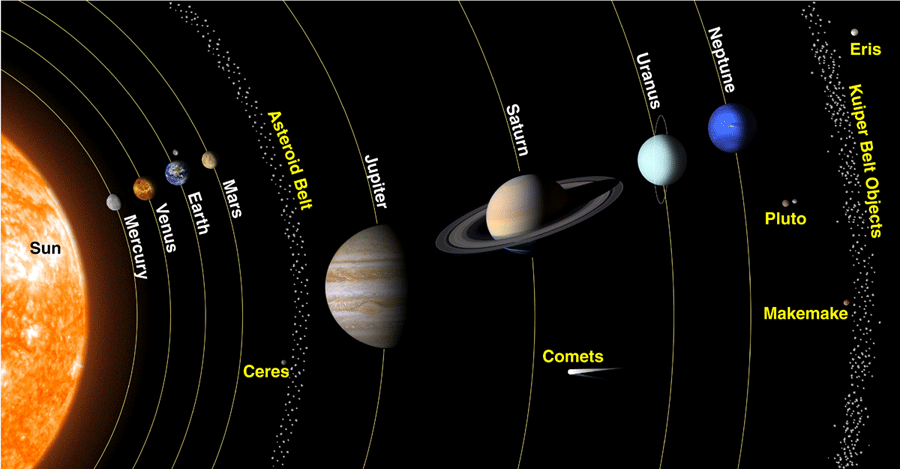
A visual representation of our Solar System
We are talking about some extreme distances, and yet some of these planets are still easily seen on a clear night. Remember that unlike stars, planets do not give off any of their own light. They are merely “reflecting” the Sun’s light off their surface back to us, even at these extraordinary distances! There are only five planets we can see without optical assistance as they are the biggest and closest (close being a relative term) to us. The five we can see naked eye are, Mercury, Venus, Mars, Jupiter, and Saturn. Mercury is almost impossible to see because it lies so close to the Sun. All the others, despite their immense size, are just too far away to see without a telescope.
When you are looking up in the night (or very early morning) sky and you see some very bright “stars” you are more likely to be looking at a planet, not a star. Venus is one of the brightest objects in the night sky. We sometimes call it the “Morning Star” because that is typically when it is its biggest and brightest as it rises over the morning horizon before sunrise. It is also (along with Mercury) seen in “phases” (being only partially lit like a crescent), just like our Moon, because they lie between us and the Sun. Jupiter is the second brightest “star”, followed by Saturn, and Mars (as that orange “star”).
Now that we’ve established where our solar system is and what lies within it, working our way in from the Milky Way, let’s work our way back out from Earth so that we can orient ourselves on where to look for these planets. We all know from grade school “astronomy” that the Earth rotates on its axis that runs from the north pole through to the south pole. If we could draw a line from the south pole, through the Earth, and out from the north pole and keep extending it outward, it would come very close to a star we call the “north star”, or Polaris. Because the Earth rotates about this axis, it appears that Polaris never moves, and that all of the rest of the visible Universe rotates around it, all night long.
But this axis is not stationary and its “tilt” changes throughout the course of a year as it orbits the Sun. While the Earth is orbiting the Sun at an amazing 67,000 miles per hour, it is also simultaneously rotating on this axis about 1000 miles per hour! So, while it may look like the stars and planets are moving around us, it is merely the Earth rotating our view of them, in and out of sight. And the path they all somewhat follow is what we call the “ecliptic”.
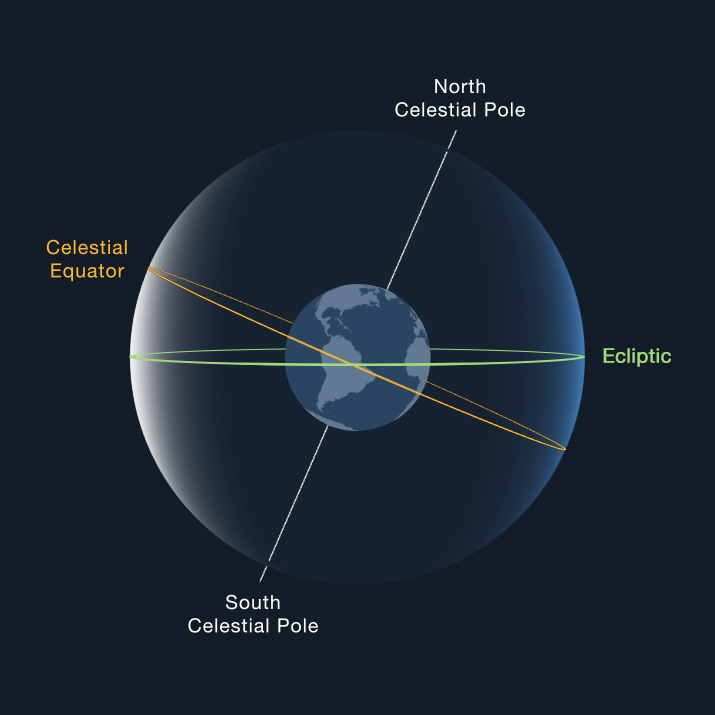
The Polar Axis, Celestial Equator and the Ecliptic
Just as the polar axis draws an imaginary line out to Polaris, an invisible, imaginary ring around the Earth, the celestial equator is more like The Earth’s equator extended out beyond our planet. There is another imaginary line around our planet and it is our orbital path around the Sun that all other planets take as well. It is called the ecliptic. Because the Earth’s axis changes its tilt, the celestial equator in the sky also changes with it, but this ecliptic does not move with it. And the ecliptic is the basic path that the Sun, Moon and planets all relatively follow as the Earth rotates causing everything to appear to be moving higher or lower along it. This is why you will see the Sun and planets higher or lower in the sky at different points in the year.
Have you ever noticed that the Sun’s path changes throughout the year? During the summer months it rises further in the east and sets further in the west, rising almost overhead during the longest days of summer. Yet in the winter it rises more to the southeast and stays low in the sky, setting more in the southwest. The planets do that same thing, being higher during “planet viewing” season (the summer and early fall) and quite low to the horizon during the winter months. This is due to the Earth’s axis tilting more away from the ecliptic in the winter.
This is an important thing to remember when looking for planets. We often get a better view of these planets during late summer, because the Earth is tilted in a more favorable position to view them higher in the sky. We will never see the Sun, Moon or planets in the northern sky. They all ride along, close to this ecliptic in the southern part of the sky, higher in the summer and lower in the winter. And because the Sun follows this path, the days are shorter in the winter and longer in the summer.
The Moon does a similar thing, but due to its close proximity to us, you will notice that the Moon doesn’t seem to follow the ecliptic quite as closely as the planets do. The Moon, just like the inner planets of Mercury and Venus goes through phases. The first phase is called a New Moon, when the backside is lit, and we don’t see it at all. But it still rises in the east and sets in the west (just as the Sun and planets do). The eight phases are, in order, new Moon, waxing crescent, first quarter, waxing gibbous, full Moon, waning gibbous, third quarter and waning crescent. The cycle repeats once a month (every 29.5 days). All throughout the month, rising higher and higher and then lower and lower as it goes through its phases, seemingly following its own path, but also only in the southern sky.
So now that we know where our solar system is within our Milky Way galaxy, and where the Sun, Moon and planets are within the solar system in relation to our Earth, we can then find these things with relative ease. And even though everything in the Universe is constantly on the move, we can now understand where to look for these objects. The Sun, Moon and planets will all show themselves in the southern sky (for those of us in the northern hemisphere) following along the ecliptic. So, we now know they can’t be in the northern sky, and in the winter will not be extremely high in the sky nor extremely low in the summer sky.
We can find them by scanning the ecliptic along the southern sky. The four major planets of Mars, Venus, Jupiter and Saturn will be viewable either in the night sky after sunset or morning sky before sunrise, but always along this imaginary line. So those brightest “stars” at night? They may not be stars at all, but the large, closer planets in our solar system.
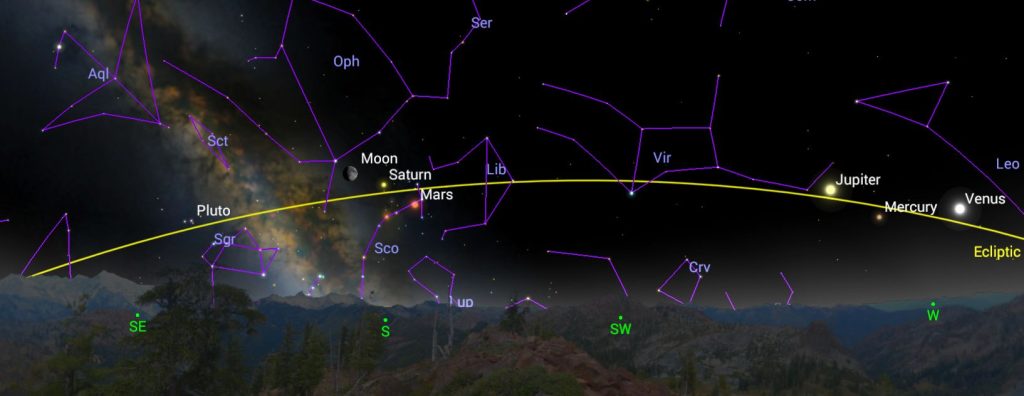
The Moon and planets move along the Ecliptic
We now have “apps” for our phones that will show the actual location of these planets on any given night, including when they rise, where they will be at their highest, and when they set. And remember this changes throughout the course of the year. There are a lot of phone apps to choose from, but by far the best is SkySafari Plus (the current version being “7”). Some apps are completely free, and some charge a small fee, but are worthy of having when you want to find something up in the night sky. Sky Safari is a planetarium app that shows where everything is out there. It uses the GPS, compass and gyroscope on our phone to easily locate everything out there imaginable. You simply open the app and point it up in the sky, and as you move it about the sky it is an accurate map of the night sky showing right where all these objects are.
Look up. You can see the Moon and many planets unaided. But even using binoculars you can see Jupiter and four of its moons, and even a little bit of Saturn’s ring sticking out to its sides. With bigger and bigger telescopes you can see even more detail (as well as more planets that lie further out beyond our eyesight, but that is for another blog where I’ll dive into equipment. For now, see if you can locate the planets and follow them throughout the year. Observing the planets can be very rewarding, even without optical aid. They alone can give us much needed perspective. Remember, the ancient astronomers had no telescopes, though they also had no light pollution either.
In my next blog, I’ll reveal even greater spectacles one can see without optical aid.